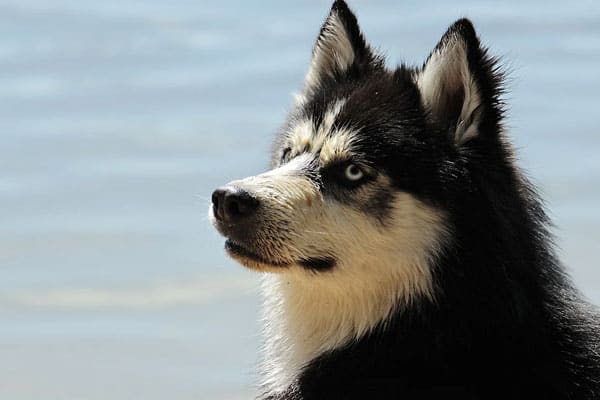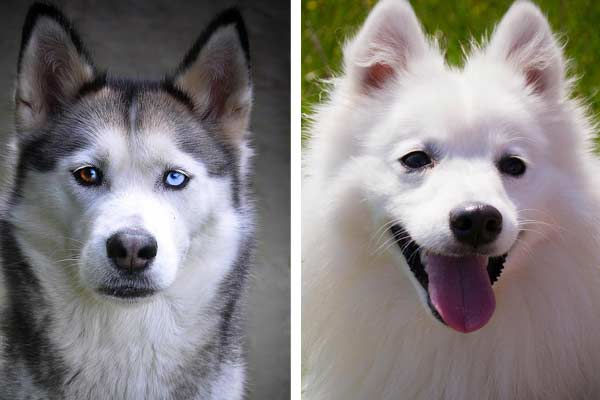Can Two Female Siberian Huskies Get Along: What to Know About These Unique Pack Dogs

Siberian Huskies first became famous on an international scale in 1925. This was when a sled dog team delivered Diptheria serum to a remote village in Alaska, saving countless villagers’ lives.
So the first real introduction that sled dogs had to mass general society was as pack dogs – dogs that live and work in groups of Siberian Huskies.
Often, this leads Siberian Husky owners to decide to get a second Husky to keep their first Husky company. But this isn’t always a great idea. A better idea is to first ask yourself, can two female Siberian Huskies get along?
This is the topic we will delve into in this article.
Can Two Female Siberian Huskies Get Along?
The short answer to this question is “it depends.” In general, female Siberian Huskies are known to be more independent and territorial than are male Siberian Huskies. For every account of two well-socialized female Siberian Huskies getting along very well together, there is an opposite account of two females fighting non-stop, sometimes to the point where an injury results.
Just like people, Siberian Husky dogs seem to prefer to pick their own friends and their own pack members.
Rather than assuming two female Siberian Huskies will get along and making a commitment you can’t take back, it is a lot smarter to give the two dogs a chance to meet and see what happens.
Watch Two Female Siberian Huskies Playing Together
In this owner-made YouTube video, you can see an example of what it looks like when two female Siberian Huskies get along and enjoy each other’s company.
This is a best-case scenario and it is great when it works out this way.
But too many Siberian Husky owners have learned the hard way that sometimes two female Siberian Husky dogs won’t get along no matter what they try. It really does depend on the individual dogs.
The Differences Between Male and Female Siberian Husky Behaviors
As Warsaw University of Life Sciences Department of Genetics and Animal Breeding explains, there are some very distinct differences between the behavior of male versus female Siberian Huskies.
In one carefully designed research study, researchers looked at behaviors within a pack of Siberian Huskies that included four unrelated adults and 10 pups related to the two adult females within the pack.
The researchers made observations about pack dynamics over the course of 12 months. What they noticed was surprising and intriguing.
In male Siberian Huskies, a clear hierarchy soon emerged that kept the pack dynamics orderly and organized.
However, in female Siberian Huskies, there was no clear hierarchy and both adult female Siberian Huskies displayed consistently dominant behavior.
There was also a lot of overt dominant behavior on the part of the two senior adult females towards the younger female dogs in the pack.
Perhaps most interesting of all, there was no evidence of displays of dominance between any of the adult males towards the adult females or vice versa. In this arena, the pack relations were cordial and non-competitive.
As this popular Husky owners thread demonstrates, in many cases real-life owner experiences point to the importance of the individual dogs rather than gender as the most important factor of success.
As the owners on the thread are discussing the best pairing – two females, two males or a male and a female – there is no standardization simply by breed.
Rather, it is clear that each dog decides for himself or herself whether to tolerate or befriend another Husky regardless of gender.
Is It Okay to Keep a Siberian Husky As An “Only Dog?”
As the Husky Rescue KZN charity points out, some Husky experts believe that the Siberian Husky’s long lineage of working and living in canine packs means these dogs don’t do well alone.
This is why some people advise that if you are going to get a Siberian Husky you should always get at least two. But there is no specific science to support this.
Here again, however, this is often up to the individual dog. It can also be up to you, the owner, and to your lifestyle and available to be a companion to your dog.
If you add a second Siberian Husky to your family just because you assume your first Siberian Husky is going to be lonely without another Husky to play with, you may find out the hard way that the two dogs don’t like each other at all.
Siberian Huskies, like most dogs, need a lot of human companionships to be happy. Adding another canine to the family is not going to be a substitute for your attention or the attention of your human family members.
If your first Siberian Husky does not get along with the second Siberian Husky, the situation may grow even worse when both dogs then become jealous of the time you give to each dog.
There is no reason to assume that your Siberian Husky will benefit from the addition of a second Husky dog unless you see obvious signs that your dog is lonely or bored or depressed.
If you do see such signs, the best approach is to try to correct it in other ways first before adding another dog to the family and twice the work to your own schedule.
For individuals and families that plan to make their Siberian Husky the center of family life and have a lot of time to spend with a dog, adding a second dog may even cause more conflict because your first dog may perceive the new dog as a threat.
Consider Pairing a Female Siberian Husky With a Male
Nakkitta Siberian Huskies kennel and breeder advocates for pairing a female and a male Siberian Husky rather than two females for the best possible potential home life.
But here again, the breeder also states that there are families who have chosen to bring home two females or two males and all has worked out well.
The important thing is to make sure both dogs are “fixed” (neutered or spayed). Otherwise, when the female Siberian Husky goes into heat (becomes fertile), this may cause problems between them.
What to Consider When Bringing Home Two Siberian Husky Puppies
As Catering to Cats & Dogs rescue charity explains, Siberian Huskies are definitely not the right dog breed for all families and individuals.
Siberian Huskies are not considered suitable for first-time dog owners or for any owner who does not have an active lifestyle.
While Siberian Huskies do display more “pack” behavior than most other modern purebred dog breeds, as the charity explains, ultimately you and your family will be viewed as your Siberian Husky’s pack.
This is why another dog may be viewed as a threat or an interloper rather than a fellow pack member.
This is not only true of adding another dog to your family. It can be especially problematic when it comes to cats and small prey-like pet species. Huskies are well-known for their prey drive and chase instinct.
In cases where you want to add another pet or a cat, the best approach is to bring them in when your Husky is still a puppy and supervise all contact. This gives you the best chance that your Siberian Husky will learn these animals are not prey.
However, there are no guarantees when you have a dog with the type of high chase and prey instinct that the Siberian Husky possesses.
Can a Female Siberian Husky Get Along With a Female of Another Dog Breed?
Now that you know that adding a second Siberian Husky to a home where you already have one female Siberian Husky can often be challenging, you might be wondering if it would be better to add a different dog breed.
For example, can a female Siberian Husky get along with another dog that happens to be female?
As this Siberian Husky owner forum on Breedia shows, here again, it may be smarter to get a male for your second dog than another female.
This is especially the case if one or both of the dogs is not yet spayed or neutered. If this is the case, do everything you can to wait until both dogs can be fixed before introducing them to one another.
Early and Ongoing Socialization Is Key to Success with Siberian Huskies
Bark Busters canine training explains that the personality of the Siberian Husky is known to be stubborn and independent by nature.
This comes with the territory for a dog that has been bred through centuries to work long hours in difficult terrain, often making split-second decisions about navigating safely without consulting “their” people.
Huskies in general are known to be challenging to train for this reason. They may not obey reliably, especially if they do not grasp the reason for the command.
Basic commands like “sit,” “stay” and “down” may not resonate with a true working dog breed that is bred and trained to run nonstop for hours and days at a time.
This is another reason why Siberian Husky dogs are not recommended as pet dogs for first-time dog owners. They are difficult to train and need a lot of early and ongoing socialization to figure out how to be a pet dog rather than a working dog.
Because Siberian Huskies are never alone in their native environment, working in big sled dog teams with groups of humans always nearby, they can also develop fears like separation anxiety if left alone or even if left with another dog.
This is unnatural for the Siberian Husky breed. These dogs are active and used to being a part of a wider circle of people and animals.
So adding a second dog to your household is not going to “solve” problems with a bored, restless, anxious, or lonely Siberian Husky in the way it might with another dog breed. At this point, it doesn’t even matter if the second dog is male or female.
For this reason, it is vital to evaluate your life, your lifestyle, your available time, and your interest in athletics before deciding that a Siberian Husky is the right choice of canine companion for you.
When a Siberian Husky stays busy and active for hours every day and has lots of outlets to play and run and jump and get lots of socialization by your side, it is not likely you will need to add another dog to enrich your Husky’s life.
Canine Athletics That Siberian Huskies Excel In
As the American Kennel Club (AKC) Siberian Husky breed profile explains, Siberian Huskies are natural canine athletes.
These dogs are born to enjoy canine athletic programs such as rally (obedience), agility, racing, endurance hauling, sled pulling, and other formal disciplines.
These programs and the competitive events they often sponsor can also provide a great way for your Siberian Husky to socialize with other Huskies of both genders in ways that are natural and enjoyable to your dog.
So canine athletics programs and events offer you both a great outlet. You don’t have to take on the expense and extra work to train, socialize and incorporate a second Siberian Husky dog into your household.
And your dog gets all the socialization and exercise they need by participating in canine sports with other dogs and with you and other people.
Will Two Female Siberian Huskies Be Friends?
If you have your heart set on bringing a second female Siberian Husky into your family, then there are some things you can do to make the likelihood of success higher.
Be sure both dogs are spayed first. Introduce them first on neutral territory. Feed them in different places and spend quality time with each dog alone.
Supervise interactions for the safety of both dogs. Involve both dogs in canine sports to give them positive (and exhausting) outlets and keep family time harmonious.





